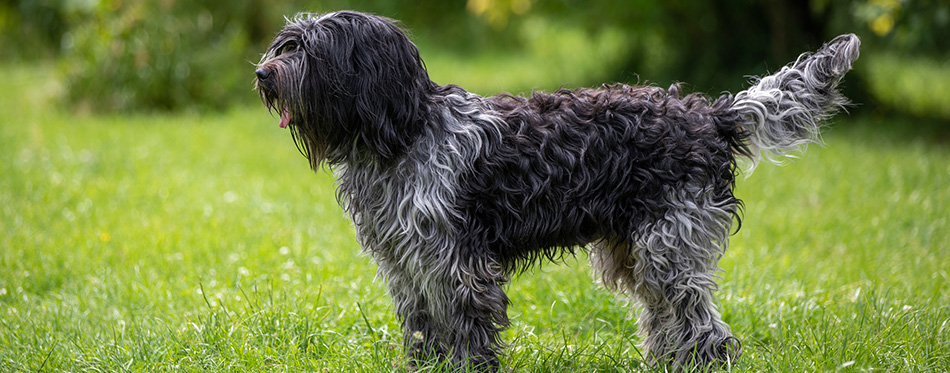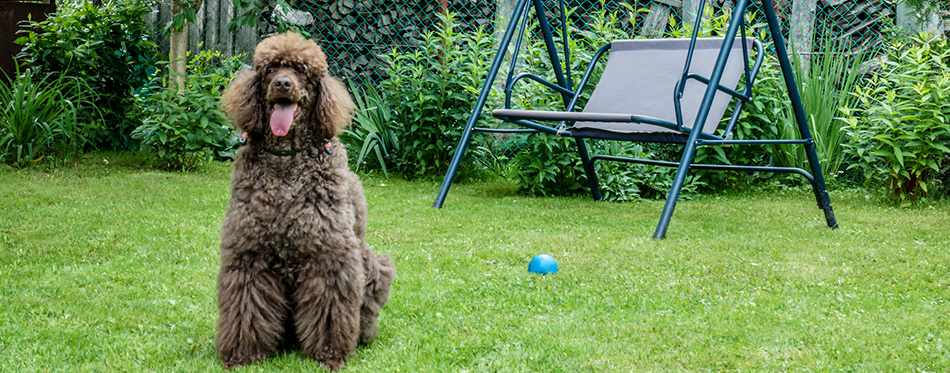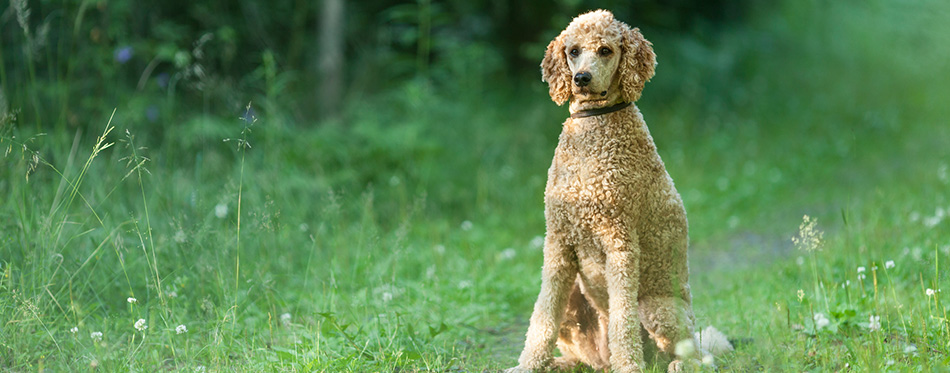Personally, we adore the Old English Sheepdog with its unmistakable shaggy coat that covers even its lovely round eyes. We also love the elegance of the Poodle especially when groomed with its impressive hairdos complete with blue and red ribbons. Now try putting the two together and you’ve got one of the loveliest, easiest to train, and sweetest designer dog breeds you can find. The Sheepadoodle is a friendly, playful, and adventurous hound that is well-suited for active families who are in their initial stages of owning a dog. This lovable hound can also be yours to keep if you know how to take good care of it.
History of the Sheepadoodle
Sheepadoodles have been around since the early- to mid-1980s, although we’d like to believe that they could perhaps have been developed as early as the middle of the 20th century. For example, we know that the Labradoodle (a cross between a Poodle and a Labrador Retriever) has been around since the early 1950s with the first mention of the term in 1955. The Goldendoodle, on the other hand, was developed in 1969 by Monica Dickens although it only became popular in the 1990s.
What are we trying to imply? Since there is no written evidence as to who or when the Sheepadoodle was first bred, we can only base our assumptions on the general trend of growing designer dog breeds. Since crossbreeds only grew in popularity sometime in the last 20 or so years, we cannot say that they were first bred within the same period.
History shows that it took 30 to 40 years before the Goldendoodle and the Labradoodle became mainstream. It is also possible that the Sheepadoodle may have already been around since the 1960s well into the 1970s, but it’s only in the 1990s that people began appreciating what hybrid dogs could bring to the table.
Of course, it is highly plausible that the Sheepadoodle is a relatively new creation. Since the 1990s saw an increasing awareness in the presence of designer dog breeds, we can only speculate that some enterprising fellow decided it’s about time to produce a cross between the OES and the Poodle.
Who knows? Maybe you have an idea and care enough to share with our other readers.

Who are the Parents?
We may not know who created the first Sheepadoodle, but this one is certain: it’s a hybrid dog that incorporates the many fine qualities of the Old English Sheepdog and the lovable characteristics of the Standard Poodle. So, who are these two anyway?
Old English Sheepdog
One look is all it takes to recognize an Old English Sheepdog. It is one of the very few breeds of dogs that have a very unique shaggy, disheveled coat. However, underneath this unkempt appearance is a dog that is known for helping farmers and livestock owners drive their sheep and cattle all the way from the farm to the market. When not on the field driving livestock, the OES can be seen lounging comfortably inside its master’s home. It enjoys home life as much as it does driving livestock.
The OES has a sense of humor that has been highlighted in many animated films. It’s a favorite of children, despite its hulking size. Its intelligent, easy-going, and fun-loving nature makes the OES a venerable family companion, but only for those who can match its energy levels. It will play all day and show you just how much of a comic genius it is. But if there’s one thing that you won’t see in the OES, that will be lying idly for a long time. It is a working dog, after all.
The main issue with the Old English Sheepdog is that it has become so fond of its family that it can suffer a really bad case of doggie separation anxiety if it is left all alone for extended periods. It loves its family so much that it is more than willing to extend its cattle driving skills to protecting and guarding its family.
For allergy sufferers, the OES isn’t the best dog to have. Its long and shaggy coat is prone to tangling and matting that a lot of owners who simply don’t want to go through the process of daily combing and brushing have the coat trimmed short. This doesn’t address the dog’s tendency to shed, though.
Poodle
Depicted in media and children’s films as being French, the Poodle is more of a German dog that is bred specifically to hunt for waterfowls especially ducks. This is something that many folks don’t know about the breed. All they know is that the Poodle is a runaway winner in many dog show competitions whether it is for conformation, agility, obedience, and tracking. What many fail to realize is that the dog world’s second smartest deserves more credit than it is currently receiving.
The Standard Poodle is a super-efficient bird and duck hunter. It has webbed feet that makes it super easy for it to swim and retrieve downed fowl. It has a moisture-resistant and wavy coat that functions more like a wool jumper in moist environments. Its working intelligence doesn’t need second or third tries on the obedience training circuit. And when it comes to sheer stamina, the Poodle won’t lag behind the likes of the Husky and Lab.
One of the most prized qualities of the Poodle is its low-allergenicity. It sheds, but so minimally that many consider it as a hypoallergenic dog. This is one of the fundamental reasons why the Poodle has always been used in many crossbreeding programs in an effort to produce a brand-new dog that has the Poodle’s hypoallergenic potential plus a handful of other desirable traits like intelligence, sociability, easy trainability, and high energy.
Because Poodles are highly sociable, they may also be prone to separation anxiety. As such, they are perfect for households that are never empty any time of the day. The Poodle loves being around its family especially the kids, playing with them the whole day.
Quick Facts
The Sheepadoodle was most likely designed to negate the allergenic tendency of the Old English Sheepdog with the hypoallergenic qualities of the Standard Poodle. Aside from this, the Sheepadoodle can also present with the following.
- On the average, it can grow anywhere between 13 inches to 24 inches, with some reaching up to 28 inches especially if the breeder used a really tall Old English Sheepdog.
- Depending on whose gene is more dominant, the Sheepadoodle can be as light as 45 pounds or as heavy as 80 pounds.
- Barring any incident in early life, the Sheepadoodle can reach a ripe age of 15, with the minimum set at 12 years.
- The face of the Sheepadoodle can be round or square, but always with a rather elongated muzzle.
- The ears hang fully relaxed on the side of their head.
- Sheepadoodles have small, buttonhole-looking eyes.
- Their coat can be as curly as a Poodle’s or straight yet disheveled as an Old English Sheepdog.
- Sheepadoodle puppies are either white or black or even both. Some Sheepadoodles take on the color markings of a panda, making them even more adorable than they already are. There are also those that come with red and white coats, although expect these to be more expensive. The rarest colors for a Sheepadoodle are gray and brown or chocolate.

Things You Should Know
Mixing the Old English Sheepdog’s playful nature, fluffy coat, and sweet temperament with the Poodle’s hypoallergenicity, intelligence, and easy trainability seems like the perfect combination. But let’s first see if this designer dog is best for you.
Training
Just because the Sheepadoodle has an Einstein, Jr. as one of its parents and an equally-smart herding dog doesn’t automatically mean you can skip the training aspect of pet parenthood. The thing is that all dogs need to be trained straight from being puppies so they’ll know the basic rules in your home. The same is true with the Sheepadoodle. It needs to be trained on where to pee and poop as well as how to control its otherwise-exuberant attitude.
The good news is you’ll never sweat training the Sheepadoodle. You only need to use one of the best and proven methods of instilling learning in canines – the use of rewards such as delicious snacks, favorite doggie toys, plenty of hugs, and even extended playtime. As long as they are able to associate what they’re doing with pleasurable sensations, the Sheepadoodle will keep on doing the things you want it to do. You don’t have to be a professional dog trainer, too, to handle the Sheepadoodle. It is one of the very few hybrids that don’t have a stubborn streak.
Feeding
The Old English Sheepdog has a voracious appetite, especially after a long day herding livestock for its owner. This trait can be easily passed onto the Sheepadoodle. Be careful. Again, instead of telling you to give the OES-Standard Poodle Mix with a certain number of cups per day, you’ll have a much better chance of ensuring it gets the correct amounts of calories and nutrients if you do a little math.
Suppose you have an unneutered, 70-lb Sheepadoodle that has a normal activity level. Get its weight in kilograms by dividing 70 with 2.2 to obtain 31.8. Raise this to 0.75 or ¾ to get 13.39 or 13.4 then factor in 70 to obtain 938. Since it’s unneutered with normal levels of activity, multiply 1.8 to get 1,688.4. This means that this particular Sheepadoodle should get 1,650 to 1,700 calories per day. If you decide to feed it 3 times a day, that’s 550 to 567 calories per meal. This is a large dog so you may want to feed it thrice daily with smaller portions to minimize bloat.
As for the ingredients of the dog food, it should be animal proteins first with a good blend of antioxidant-rich veggies and fruits, gluten-free and low-glycemic carbs, and healthy fats.
Check out our guides on Organic Dog Food and Grain Free Dog Food for more info.
Exercise
Both of the Sheepadoodle’s parents are working purebreds. It is not unusual that the Sheepadoodle will also retain the high-energy playfulness of its parents. As a matter of fact, plenty of playtime could very well be an excellent substitute for exercise. As long as it could run, jump, and goof around in your backyard or any other wide open space, it should be perfect for this designer dog breed.
While a good amount of outdoor playtime such as playing fetch or a simple tug of war with the Sheepadoodle, it would give it more benefits if you can also add mental stimulation to its daily repertoire of activities. Puzzle toys, squeaking toys, and interactive toys are all great tools to sharpen the mind of the Sheepadoodle. Alternatively, you can introduce treats into food dispensing puzzle toys so you’ll be hitting two goals with a single shot. For more options, check out our detailed review of interactive dog toys.
Socialization
To put it simply, the Sheepadoodle was bred specifically to be your family companion. It loves being around its folks, especially its masters’ children. However, do take the time to teach very young kids on how to properly handle such a dog. Your kid may pull on the dog’s ears and hurt your pet. Worse, it may snap and growl at your kid. Better be cautious.
If you also have other pets at home, the Sheepadoodle will easily welcome them, too. While the Poodle is a bird hunter and the Old English Sheepdog is a herder, they don’t necessarily have a strong prey drive. This can also be easily mitigated if you can socialize it as a puppy. The earlier it gets acquainted with everyone else in the ‘hood, the more well-balanced your dog is socially.
Grooming
One of the reasons why the Sheepadoodle was created was to obtain the hypoallergenic properties of a Poodle and integrate it in the cuteness of the OES. However, it is still a very hairy dog. And like all that have fluffy hair on them, frequent brushing and combing is a fundamental requirement. How frequent you ask? If you can do it every day, then why not? But, at the very least, you should comb it every other day.
Bathing the Sheepadoodle is best done once or every two months, depending on how fast it can get dirty. Using an appropriate dog shampoo is also a must. Dental care and ear care should be performed daily and biweekly, respectively. Trimming the nails every 3 weeks is ideal, although you can play it by ear.
Check out our articles on Dog Dental Spray, Dog Flea Combs, Dog Grooming Table, Puppy Shampoos and Dog Nail Clippers.

Health
There is not one living organism, man and dog included, that is ever completely free from disease. If you want a dog that is disease- or illness-free, you’d have a much better luck looking for a needle in a haystack. The same is true with the Sheepadoodle. While it is a sturdy designer dog, there are still some diseases that it can be especially prone to. Hip dysplasia, skin allergies, and bloat are just some of the more common. The more serious ones can include Cushing’s disease and Addison’s disease.
Genetic testing can help unearth some of the disease markers that a Sheepadoodle may inherit from its forebears. Alternatively, a friendly chat with its designer dog breeder can elicit information about the health status of the dog’s parents. This will help you get a good glimpse on what’s in store for you and the Sheepadoodle.
Get a Sheepadoodle if you…
- And your family lead a generally active lifestyle
- Can commit to training it as a puppy using only proven positive reinforcement methods
- Or anyone else in the family is diagnosed with dander hypersensitivity
- Love playing with dogs
- Can socialize it as a puppy
You’re better off with another dog if you…
- Don’t want to comb or brush a dog’s coat at least 4 times a week
- Will leave it alone by itself for more than 8 hours at a time
Temperament
Because of its playful nature and affectionate personality as well as a gentle temperament, the Sheepadoodle is a great family pet. However, its playfulness and boisterous energy need to be tempered right from the beginning especially if one has very small children at home. There’s nothing that a Sheepadoodle would want more than to be with and around its human family. It is loyal and can be trusted with kids. In fact, it loves playing with them the whole day. And if kids were to have the stamina to match the Sheepadoodle’s, they’ll be playing all the way through the evening and well into the following morning. Training and socializing it is relatively easy since the hybrid already has the natural gifts from its parents. Leave it alone for long periods and you’ll have a serious case of severe canine separation anxiety in your hands. It’s a working dog, but does exceptionally well as a loving family pet, too.
Without a doubt, the Sheepadoodle is one of the friendliest crossbreeds you’ll ever see. It is very easy to train and never has a streak of stubbornness in its blood. Best of all, it’s hypoallergenic, making it great for those with hypersensitivity reactions.
Sources:
- The Sheepadoodle – Sheepdog Poodle Mix – Animal Corner

